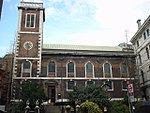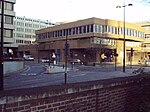Baynard House, London
Blackfriars, LondonBritish Telecom buildings and structuresBrutalist architecture in LondonBuildings and structures in the City of LondonScheduled monuments in London ... and 3 more
Telecommunications buildings in the United KingdomTelephone exchange buildingsUse British English from March 2014

Baynard House is a brutalist office block in Queen Victoria Street in Blackfriars in the City of London, occupied by BT Group. It was built on the site of Baynard's Castle. Most of the land under it is a scheduled monument. From 1982 to 1997 it housed the BT Museum.
Excerpt from the Wikipedia article Baynard House, London (License: CC BY-SA 3.0, Authors, Images).Baynard House, London
Queen Victoria Street, City of London
Geographical coordinates (GPS) Address External links Nearby Places Show on map
Geographical coordinates (GPS)
| Latitude | Longitude |
|---|---|
| N 51.511918333333 ° | E -0.10122333333333 ° |
Address
BT
Queen Victoria Street 135
EC4V 4AA City of London
England, United Kingdom
Open on Google Maps









